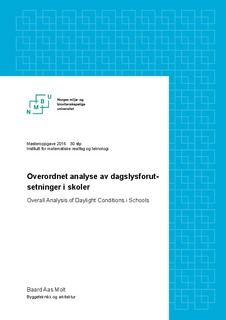Overordnet analyse av dagslysforutsetninger i skoler
Master thesis
Permanent lenke
http://hdl.handle.net/11250/2402763Utgivelsesdato
2016-08-30Metadata
Vis full innførselSamlinger
- Master's theses (RealTek) [1722]
Sammendrag
Enkelt verktøy for tidlig planlegging av godt dagslys i skolebygg
Godt læringsmiljø er et vesentlig begrep i all skoleutvikling i dag. I byggeforskrifter og veiledninger
vektlegges mange faktorer, også lysforhold som del av et godt innemiljø.
Det er likevel slik at fra start til slutt i et byggprosjekt er det mange hensyn som skal tas, og mange
interesser som konkurrerer om prioritet. Det er ikke nødvendigvis slik at dagslystilgang, utover
minstekravene, får være styrende for utforming av bygget. At elevprestasjoner øker i takt med
forbedret lysinnslipp, begrunnes i forskning. Da bør verktøy som legger til rette for det være
tilgjengelig tidlig i planleggingen.
Mulige vindusflater har med veggflater å gjøre. Mengde veggflater har med utforming av
bygningskroppen å gjøre. Dette arbeidet har derfor tatt for seg hvilke muligheter en har til å påvirke
dette. Eller rettere, at man tidlig i planleggingsfasen kan bevisstgjøres vesentlige valg som fremmer
eller hemmer godt dagslys inn i arbeidsarenaene.
Arbeidet er grovt sett begrenset til å undersøke om det lar seg gjøre å lage et analyseverktøy som
prosjekterende kan benytte tidlig i planleggingsfasen og slik få en pekepinn på hvilket konseptvalg
som best ivaretar dagslystilgang.
Gjennom måling og sammenstilling av relevante data fra mange arkitekturkonkurranser fra
grunnskoler, målt opp mot et svært godt referansebygg hva gjelder lysforhold, er det hentet fram
verktøy som er et godt bidrag til å svare på problemstillingen. Det er sett på hvordan lysforhold
påvirkes av bygningens form (volum), programmert areal, ulike typer rom i skolebygningene og
arealeffektivitet. Med referanseprosjektet Rykkinn skole som et oppnåelig mål har dette studiet gitt
interessante svar:
- Det er vesentlig hvilken bygningsform som velges. Et enkelt tabelloppsett tydeliggjør forholdet
mellom fasade til lysinnslipp, grunnflate og valgt bygningsform.
- Et steg to i en tidlig planleggingsfase vil være å bruke utarbeidet formel til å kvalitetssikre forholdet
mellom antall personer (elever og lærere) med hvor mye fasade som må til for å gi plass for
tilstrekkelig lysåpninger. A simple tool for early planning of good daylight conditions in school buildings.
Good learning environment is an important concept in all school development today. In building
regulations and instructions, emphasis is put on many different elements, including light conditions
as part of a good indoor environment. From the beginning to the end of a building project, there are,
however, many factors to take into consideration, and many conflicting interests striving for priority.
Beyond minimum standards, however, access to daylight is not necessarily the guiding principle for
the design of the building. This, in spite of the fact that research shows student performances
improve with increased intake of light. Thus, tools that facilitate such conditions, should be available
early in the planning process.
The availability of window surfaces is closely related to that of wall surfaces. Furthermore, the total
amount of wall surface is related to the design of the volume of the building itself. This paper has
therefore addressed how this factor can be influenced. Or rather - the fact that, early in the planning
stage, we can increase awareness concerning significant choices which will improve or inhibit good
daylight in working areas.
This paper is, generally speaking, limited to investigating whether or not it is feasible to make a tool
for analysis which can be applied early in the planning process. This can contribute to a realization of
which choice of concept will in the best way take care of daylight access.
In this paper I have described a tool which will be a good contribution to addressing these issues. This
has been done through measuring and putting together data from many architectural competitions
of primary schools, and comparing this to what we find regarding light conditions in a very good
reference building.
The study looks into how light conditions are affected by the shape and volume of the building, the
amount of floorage, different categories of rooms in the school building, and floorage efficiency.
Using the Rykkinn school as an achievable project of reference, these studies have contributed some
interesting findings:
- The choice of building design is significant. A simple table makes clear the relationship between the
facade of light inlet, the base area and the choice of building design.
- The second stage in an early phase of planning would be to make use of the formula developed
through this paper in order to assure the quality of the relationship between the number of people
(students and teachers) and the amount of facade needed to allow room for a sufficient amount of
light openings.
